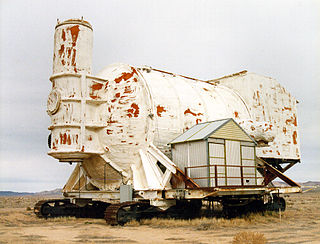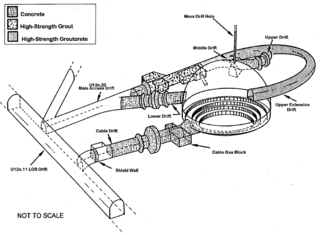Related Research Articles

Operation Tinderbox was a series of 14 nuclear tests conducted by the United States in 1979–1980 at the Nevada Test Site. These tests followed the Operation Quicksilver series and preceded the Operation Guardian series.
The United States's Niblick nuclear test series was a group of 41 nuclear tests conducted in 1963–1964. These tests followed the Operation Roller Coaster series and preceded the Operation Whetstone series.
Operation Latchkey was a series of 38 nuclear tests conducted by the United States in 1966–1967 at the Nevada Test Site. These tests followed the Operation Flintlock series and preceded the Operation Crosstie series.
Operation Quicksilver was a series of 16 nuclear tests conducted by the United States in 1978–1979 at the Nevada Test Site. These tests followed the Operation Cresset series and preceded the Operation Tinderbox series.

Operation Sunbeam was a series of four nuclear tests conducted at the United States's Nevada Test Site in 1962. Operation Sunbeam tested tactical nuclear warheads; the most notable was the Davy Crockett.
The United States's Praetorian nuclear test series was a group of 19 nuclear tests conducted in 1981–1982. These tests followed the Operation Guardian series and preceded the Operation Phalanx series.
Operation Fusileer was a series of 16 nuclear tests conducted by the United States in 1983–1984 at the Nevada Test Site. These tests followed the Operation Phalanx series and preceded the Operation Grenadier series.
Operation Grenadier was a series of 16 nuclear tests conducted by the United States in 1984–1985 at the Nevada Test Site. These tests followed the Operation Fusileer series and preceded the Operation Charioteer series.

Operation Charioteer was a series of 16 nuclear tests conducted by the United States in 1985–1986 at the Nevada Test Site. These tests followed the Operation Grenadier series and preceded the Operation Musketeer series.

The United States's Touchstone nuclear test series was a group of 13 nuclear tests conducted in 1987–1988. These tests followed the Operation Musketeer series and preceded the Operation Cornerstone series.
Operation Roller Coaster was a series of four nuclear tests conducted jointly by the United States and the United Kingdom in 1963, at the Nevada Test Site. The tests did not involve the detonation of any nuclear weapons. Instead, their purpose was to evaluate the distribution of radioactive particles in a "dirty bomb" scenario, or an inadvertent, non-nuclear detonation of a nuclear weapon, as well as to evaluate the effectiveness of storage structures in containing the explosion and the particles released. The tests followed the Operation Storax series and preceded the Operation Niblick series.
The Soviet Union's 1954 nuclear test series was a group of 10 nuclear tests conducted in 1954. These tests followed the 1953 Soviet nuclear tests series and preceded the 1955 Soviet nuclear tests series.
The Soviet Union's 1953 nuclear test series was a group of 5 nuclear tests conducted in 1953. These tests followed the 1949-51 Soviet nuclear tests series and preceded the 1954 Soviet nuclear tests series.
France carried out a series of 24 nuclear tests from 1971–1974 These tests followed the 1966–1970 French nuclear tests series and preceded the 1975–1978 French nuclear tests.
The France's 1979–1980 nuclear test series was a group of 22 nuclear tests conducted in 1979–1980. These tests followed the 1975–1978 French nuclear tests series and preceded the 1981–1982 French nuclear tests series.
The France's 1981–1982 nuclear test series was a group of 22 nuclear tests conducted in 1981–1982. These tests followed the 1979–1980 French nuclear tests series and preceded the 1983–1985 French nuclear tests series.
The France's 1983–1985 nuclear test series was a group of 25 nuclear tests conducted in 1983–1985. These tests followed the 1981–1982 French nuclear tests series and preceded the 1986–1988 French nuclear tests series.
The 1986–1988 French nuclear tests were a group of 24 nuclear tests conducted between 1986 and 1988. These tests followed the 1983–1985 French nuclear tests series and preceded the 1989–1991 French nuclear tests series.
The France's 1989–1991 nuclear test series was a group of 21 nuclear tests conducted in 1989–1991. These tests followed the 1986–1988 French nuclear tests series and preceded the 1995–1996 French nuclear tests series.
References
- 1 2 "Time Zone Historical Database". iana.com. Retrieved March 8, 2014.
- 1 2 3 4 5 6 7 Sublette, Carey. "Nuclear Weapon Archives" . Retrieved January 20, 2013.
- 1 2 3 4 5 6 7 Sublette, Carey. "Nuclear Weapon Archives" . Retrieved January 20, 2013.
- 1 2 3 4 5 6 7 Norris, Robert S.; Burrows, Andrew S.; Fieldhouse, Richard W. (1994). Nuclear Weapons Databook, Vol. 5: British, French, and Chinese Nuclear Weapons. Boulder, CO: Westview Press.
- 1 2 3 4 5 6 7 Yang, Xiaoping; North, Robert; Romney, Carl (August 2000). CMR Nuclear Explosion Database (Revision 3) (Technical report). SMDC Monitoring Research.